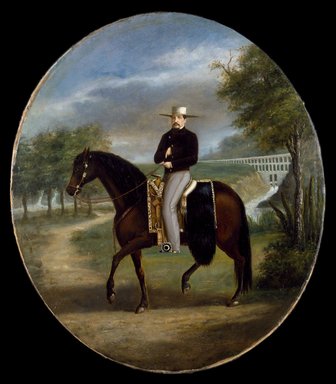Browse

| Accession # | 52.166.15 |
|---|---|
| Artist | Édouard Pingret |
| Title | Don Manuel Romero de Terreros y Villar-Villamil |
| Date | ca. 1865 |
| Medium | Oil on paper, mounted on canvas |
| Dimensions | oval: 26 1/4 x 22 7/8 in. (66.7 x 58.1 cm) frame: 32 3/8 x 29 3/8 x 3 1/2 in. (82.2 x 74.6 x 8.9 cm) |
| Credit Line | Museum Collection Fund and Dick S. Ramsay Fund |
| Location | Visible Storage: Case 24, Screen B (Paintings) |
| Description | This oval equestrian portrait in oils of Don Manuel shows him dressed in the national "Charro" costume on a horse facing to the left. The saddle and accessories are still used today with variations in Mexico. He has black hair and a large mustache. He holds the reins in his left hand while the right one is in his vest. In the landscape background is the monumental aqueduct "El Sitio" part of his hacienda "Xalpa" which was started by the Jesuit fathers in Colonial times and which Don Manuel completed in the middle of the 19th century. He renounced his titles of nobility because of his liberal ideas. He served as Senator of the Republic and Governor of the Federal District (Mexico City). He was very fond of horses and his serapes are at the Museum. Condition: Good with some small cracks at the top. |
Curatorial Remarks: In his full-length equestrian portrait, Don Manuel commemorated one of his greatest achievements, the completion of the aqueduct of Tepotzotlán (more commonly known as the Arcos de Sitio) outside Mexico City. Born into one of Mexico’s leading Creole families, he had renounced several ancestral titles and associated properties by the time he assumed the role of governor of the Federal District (Mexico City). In his short term, he promoted the establishment of charities, improved local hospitals, and reformed the jails.
When Napoleon III installed Archduke Ferdinand Maximilian as puppet emperor of Mexico in 1864, Don Manuel, a staunch Mexican patriot and liberal idealist, immigrated to France. He lived there through Maximilian’s fall in 1867 (his portrait and that of his daughter, illustrated below, were probably commissioned at that time), supporting Mexican liberals expelled by the short-lived European regime. After the defeat of the empire, he returned to Mexico, where he remained for the rest of his life.
En su retrato ecuestre de cuerpo entero, don Manuel conmemora uno de sus grandes logros, la culminación del acueducto de Tepotzotlán (más comúnmente conocido como Arcos de Sitio) en las afueras de la Ciudad de México. Nacido en el seno de una de las familias criollas más importantes de México, don Manuel había renunciado ya a numerosos títulos ancestrales y propiedades asociadas a ellos para cuando asumió el papel de Gobernador del Distrito Federal (Ciudad de México). En un corto periodo, promovió el establecimiento de obras de caridad, mejoró hospitales locales y reformó las cárceles.
Cuando Napoleón III instaló al Archiduque Ferdinando Maximiliano como emperador marioneta de México en 1864, don Manuel, leal patriota mexicano y liberal idealista, emigró a Francia. Vivió allí, apoyando a los liberales mexicanos expulsados por el efímero régimen europeo, hasta la caída de Maximiliano en 1867. Su retrato y el de su hija (ilustrado debajo) fueron probablemente encargados en esta época. Después de la caída del imperio, retornó a México, donde permaneció por el resto de su vida.